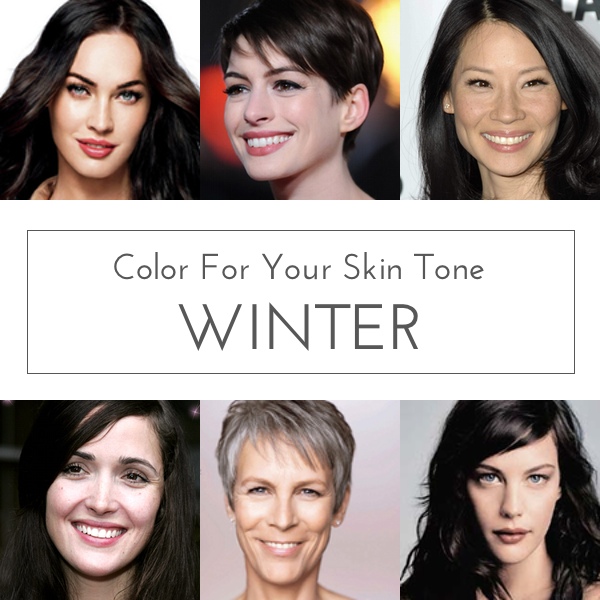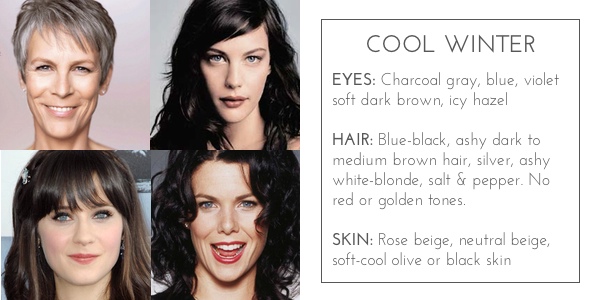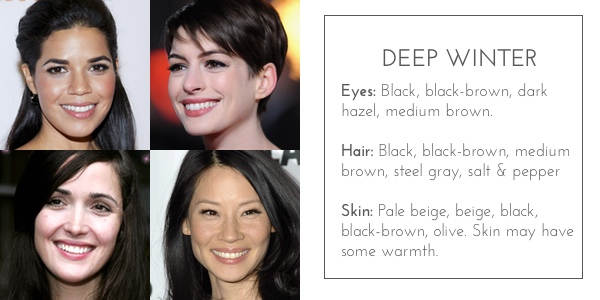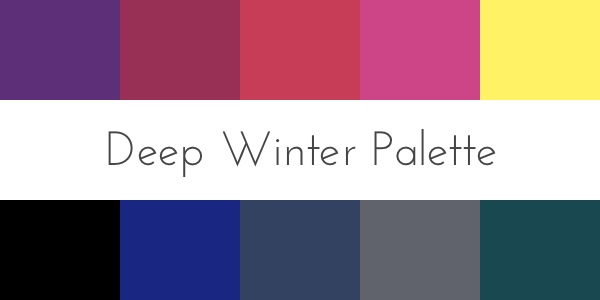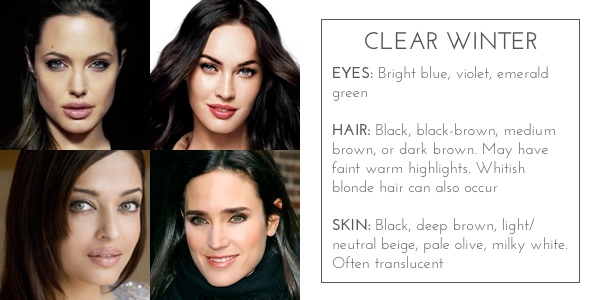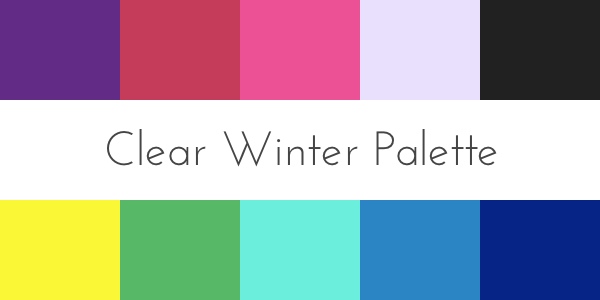In our previous series The Ultimate Guide to Color Theory for Sweater Knitters we looked briefly into seasonal color analysis and how it can work with the color wheel. Now we’re looking at each season a little bit deeper and including a few modifiers to be more specific within each season. Ultimately the goal is for you to find your absolute best colors! Once you have an idea of which colors look best on you it can be translated directly into your sweater knitting.
[title text=”Winter Basics” style=”bold_center”]As a Winter you have a lot of depth to your coloring with bluish or pinkish undertone.
You have a bluish or pinkish undertone to your skin. Some olive-yellow undertones may be visible but to a lesser extent than the cool undertones.
Your eyes are intense and you have a high contrast between your hair color, eye color and skin tone or an overall deep look with olive to black skin, dark eyes and black-brown hair.
Winter coloring is very vivid – which is why you shine in black and other colors that have a strong jewel quality to them.
Your hair is typically very dark, ranging from deep medium brown to jet black. As you age your hair will turn a grey or salt and pepper color. In some instances a Winter can have blonde hair, but it is very cool and almost white looking.
Within the overarching Winter category there are three subcategories, cool, deep and clear. Each of these modifiers has one or two distinguishing features that hopefully will help you determine your very best colors!
[title text=”Cool Winter” style=”bold_center”]As a cool Winter, its vital to steer clear of any warm colors. Stick with cool blues, purples, reds and anything that isn’t warm. While wearing cool colors is the main concern, you also want your colors to be bold enough to match your strong coloring so soft pastels like sky blue or light lavender may be too wishy washy on you. It is common for cool Winters to have once been deep Winters earlier in life. As we age, our coloring tends to cool and soften. Cool Winter does not ‘flow’ into any warm season, but they can overlap with the cool Summer. Some of the more full bodied cool summer colors like raspberry, plum and deep rose can be found in this palette, and they are particularly good colors for Winter makeup.
[title text=”Deep Winter” style=”bold_center”]Deep, cool coloring allows you to wear vibrant primary colors like true red and dlue, deep neutrals like charcoal, pure white and black. Winters are the only seasons in which black truly enhances their skintones and makes them come alive (although it is usually included in the clear Spring and deep Autumn palettes, due to their high contrast level). As a deep Winter you are a blend of both Winter and Autumn , so while you will favor cool colors, you will also be able to wear the deepest colors of the Autumn palette as well such as deep chocolate brown and pine green. You will have some warmth in your coloring that you won’t see in a cool Winter, generally in your skin.
[title text=”Clear Winter” style=”bold_center”]Clear Winters look best in clear, contrasting colors. Black will always look good on you but to maximize your coloring pair it with a bright contrasting color. Clear coloring can be very striking and your palette contains all of the beautiful jewel tones like ruby red, emerald green and sapphire blue. When choosing colors to work with just make sure they are clear and bold. As a clear Winter, you are a blend of both Winter and Spring so you will find some of the most intense Spring colors in your palette like bright coral and icy yellow.
[title text=”How To Use Your Colors” style=”bold_center”]Use Your Colors As A Guide, Not A Rule
You should not rely on your colors like a fail-proof rule for every color that looks good on you. Why not? Because the 12 seasonal sub-types are not exclusive nor comprehensive. That means that you might not neatly fit into only one type and be suited to only one color palette.
If your complexion does fit one of the types well, it would be a huge shame to just ignore the all the other colors . The other palettes, especially your within your season offer a whole host of other shades to explore that will suit you just as well. Using the other palettes can help you build a more varied, yet still cohesive color schemes for your knitting needs. Use your recommended color palette as a starting point and work from there to experiment with additional colors tones and shades.
Personal Preference Trumps Color Analysis
Your color palette should never restrict your ability to express your aesthetic preference through your knitting. If your recommended colors do not match your style concept, just analyze each shade individually and decide if you can pull it off. Using the process of elimination you can begin to build a very personal color palette for yourself. If a certain shade makes you look sickly try to find a replacement that still captures the color’s essence but fits your skin’s undertone a little better.
If a colour does not look amazing but also not horrible on you, then I say go for it! I’m a warm Spring so black is definitely not one of my best colours, but I love it! Instead of the super saturated dark black I usually go for a softer grey or charcoal (and they also happen to be easier to see when I’m knitting).
Prioritize Colors Close To Your Face
The whole point of color analysis is to find colours that flatter your skin tone, hair and eye colour, in other words your face. Colors that are not in near your face might have an impact on the overall look of your sweater, but not on your complexion. As you’re planning out your next sweater project try to put colors from your recommended palette near your face. If there is a color that you love that isn’t within your palette go ahead and use it, but try using it for details or in a lower part of the sweater far from your face. For more about colors and neutrals that look great together check out these articles in our color theory series!
Traditional Color Combinations
Combining Colors and Neutrals
As you’re reading this you may discover that you’re not an Winter at all. If that’s the case don’t worry! Check out our other posts for Spring, Summer and Autumn.
